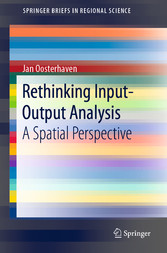
Rethinking Input-Output Analysis - A Spatial Perspective
von: Jan Oosterhaven
Springer-Verlag, 2019
ISBN: 9783030334475
Sprache: Englisch
123 Seiten, Download: 2536 KB
Format: PDF, auch als Online-Lesen
| Preface: History and Acknowledgements | 6 | ||
| Contents | 7 | ||
| Variables and Coefficients | 10 | ||
| 1 Introduction: Importance Interindustry Relations and Overview | 11 | ||
| References | 12 | ||
| 2 Basic, Demand-Driven IO Quantity Models | 14 | ||
| 2.1 Single-region IO Tables and Their Descriptive Power | 14 | ||
| 2.2 Mathematics Versus Economics of the Closed Economy IO Model | 16 | ||
| 2.3 Open Economy Interregional and Multi-regional IO Models | 20 | ||
| 2.3.1 Distinguishing Technical and Trade Origin Coefficients | 20 | ||
| 2.3.2 Underestimation of Interregional Spillovers and Feedbacks | 25 | ||
| References | 27 | ||
| 3 Data Construction: From IO Tables to Supply-Use Models | 28 | ||
| 3.1 Construction of Regional IO Tables: Towards Cost-Effective Methods | 28 | ||
| 3.1.1 Most Non-Survey Methods Overestimate Intra-Regional Multipliers | 28 | ||
| 3.1.2 Non-Survey CC-RAS Method: Advantage of Using Multiple Comparable IOTs | 32 | ||
| 3.1.3 Semi-Survey DE-BRIOT Method: Advantage of Constructing Bi-Regional IO Tables | 34 | ||
| 3.2 Construction of Interregional Supply-Use Tables and Models | 37 | ||
| 3.2.1 Difficulty of Deriving an IO Model from a Supply-Use Table | 38 | ||
| 3.2.2 Family of Interregional Supply-Use Tables and Models | 41 | ||
| 3.3 Difference Between Constructing Interregional and International SUTs | 44 | ||
| References | 46 | ||
| 4 From Basic IO and SU Models to Demo-Economic Models | 49 | ||
| 4.1 Interregional Models with Endogenous Household Consumption | 49 | ||
| 4.2 Further Demo-Economic Model Extensions | 55 | ||
| 4.3 Where to End with Endogenizing Final Demand? | 60 | ||
| References | 62 | ||
| 5 Cost-Push IO Price Models and Their Relation with Quantities | 64 | ||
| 5.1 Forward Causality of the Single-Region IO Price Model | 64 | ||
| 5.2 Type II Interregional Price and Quantity Models Combined: Lower Multipliers | 67 | ||
| References | 72 | ||
| 6 Supply-Driven IO Quantity Model and Its Dual, Price Model | 74 | ||
| 6.1 Plausibility of the Supply-Driven Input-Output Model | 74 | ||
| 6.1.1 Basic Supply-Driven IO Model: How Factories May Work Without Labour | 74 | ||
| 6.1.2 Type II Supply-Driven IO Model: How More Private Cars May Run with Less Gasoline | 79 | ||
| 6.2 Revenue-Pull IO Price Model = Plausible Dual of the Ghosh Quantity Model | 81 | ||
| 6.3 Markets: Why All Four IO Models Overestimate Their Typical Impacts | 84 | ||
| References | 87 | ||
| 7 Negative IO Supply Shock Analyses: A Disaster and a Solution | 90 | ||
| 7.1 Limited Usability of the IO Model in Case of Supply Shocks | 90 | ||
| 7.2 Nonlinear SU Programming Alternative: Much Smaller Disaster Multipliers | 94 | ||
| References | 98 | ||
| 8 Other IO Applications with Complications | 100 | ||
| 8.1 Key Sector and Linkage Analyses: A Half-Truth | 100 | ||
| 8.1.1 Analytical and Empirical Comparison of Key Sector Measures | 101 | ||
| 8.1.2 Cluster and Linkage Analysis for Three Dutch Spatial Policy Regions | 103 | ||
| 8.1.3 The Other, Cost Side of the Coin | 106 | ||
| 8.2 Structural Decomposition Analyses: Another Half-Truth | 108 | ||
| 8.2.1 Shift and Share Analysis of Regional Growth | 109 | ||
| 8.2.2 Structural Decomposition Analyses of National and Interregional Growth | 111 | ||
| 8.2.3 The Other, Supply Side of the Coin: Growth Accounting | 115 | ||
| References | 116 | ||
| 9 Future: What to Forget, to Maintain and to Extend | 120 | ||
| References | 122 |








